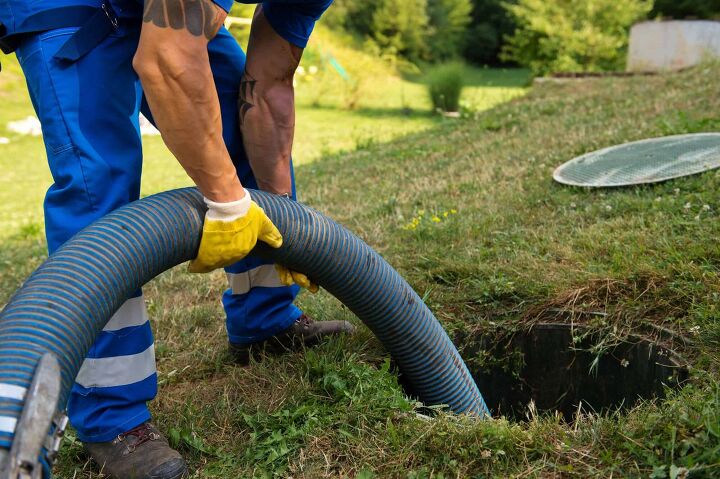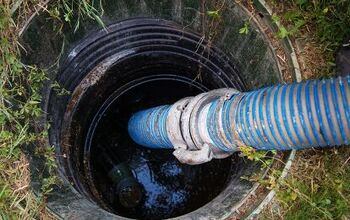Will A Flooded Septic Tank Fix Itself?

A flooded septic tank is nothing to mess around with. Your septic tank is responsible for draining all the wastewater from your home, so a flooded one poses a problem. A flooded septic tank can cause sewage to back up into your home’s drains and emit a foul odor. This is a stinky problem you’ll have to deal with sooner rather than later.
There is a very small chance that your flooded septic tank will fix itself. As soon as you notice it has flooded, call a professional to diagnose the problem. Once the ground around the septic tank and drainfield has dried a bit, the tank will need to be pumped.
Do You Need Septic System Repair?
Get free, zero-commitment quotes from pro contractors near you.

How Does a Septic Tank Work?
To understand why septic tanks flood, it’s essential to understand how a septic tank works. Otherwise, it can get a little confusing when words like “effluent,” “sludge,” and “anaerobic bacteria” are thrown around by a professional.
Septic systems are underground drainage and wastewater treatment systems that are present mostly in rural areas. A septic system usually consists of a septic tank, drainfield, and various pipes.
A septic system filters wastewater in your home. After a flush, shower, or other water-based activity, wastewater flows out of your home and into the tank. Solid waste, also known as sludge, settles to the bottom of the tank.
Anaerobic bacteria break down this sludge and release various byproducts to the top of the tank. Greases, oils, and fats, known as scum, also float to the top.
The leftover wastewater, known as effluent, is now free of sludge and scum. The effluent flows out of the pipes and into the drainfield. There are perforated pipes throughout the drainfield that introduce the effluent into the soil. Once the effluent enters the soil, harmful bacteria are filtered out.
What Causes a Flooded Septic Tank
During heavy rain, the ground around your home absorbs a great deal of moisture. The good news is this helps prevent your home from flooding. But, if you have a septic tank, the drainfield and soil around it will likely absorb water during a bad storm.
The drainfield’s main job is to provide a space for the effluent to filter through the soil. This process already lightly saturates the ground above and around the drainfield. During heavy rain, the soil meant for wastewater becomes heavily saturated with rainwater.
When this saturation happens, effluent can no longer drain properly through the drainfield’s soil. This can pose a significant problem for your septic system.
Signs You Have a Flooded Septic Tank
Just because there was a thunderstorm last night, it doesn’t necessarily mean you have a flooded septic tank. There are a few telltale signs that you have a flooded septic tank:
- Settling. If you’ve had your septic tank for longer than a year and the ground around it is sinking, you may have a problem! Settling is a common occurrence immediately after the installation of a septic system. However, if it happens years after installation and there’s been heavy rain, you likely have a flooded septic tank.
- Soggy soil. If it has been a few days since the last rain and the ground is still saturated, you have a flooded septic tank. Soggy soil is a sign your drainfield is water-logged and can no longer filter effluent as it should.
- Standing water. If a small pond has formed above your septic tank and won’t dissipate, this is a sign of a flooded system.
- A foul odor. If the ground around your septic system stinks, this is a sign that your septic system is backed up. After a storm or flood, a bad smell indicates the septic system can no longer filter wastewater as it should.
- Sewage backing up in your drains. If sewage is backing up into your drains after use, your septic tank is probably flooded. A septic system that is working properly should have enough space in the tank for wastewater to enter. After a flood, the drainfield cannot function properly, meaning the tank can’t either.
What to Do When Your Septic Tank Floods
Unfortunately, after your septic tank floods, fast action isn’t possible to solve your problem. There are few things you can do to deal with your flooded septic tank:
- Reduce water being sent down the drains. Until the flooded septic tank is fixed, you should reduce your water waste. Otherwise, you’ll continue to have sewage backing up into your drains. The average home sends about 70 gallons of water down the drain per person per day. Until the groundwater reaches a level that is below the septic tank, you must limit the amount of water used.
Until you can have your system pumped, try using disposable dishes and utensils, limit the use of your washer, and take shorter showers. If you must use your washing machine, do much smaller loads and wait several hours between them. If you can, only flush the toilet when necessary and prepare no-cook meals. - Check appliances for leaks. If any of your appliances are leaking, additional water will be sent into your flooded septic tank. This extra water will cause a problem, and you won’t even be aware of it unless you check!
- Wait for the drainfield to dry. Unfortunately, your flooded septic system can’t be fixed until the soil is less saturated. If the system is pumped before the ground is drier, the tank can fill with mud and silt. This can cause clogs down the road.
This can cause clogs down the road. Pumping while the ground is flooded can also cause the septic tank to float out of place, causing damage to both the inlet and outlet pipes. However, as soon as the water table lowers, your system should be pumped immediately. - Pump your septic tank. Once the ground has dried, call a professional. A professional can inspect and pump your system. This will rid it of additional water from the flood.
A professional can also diagnose any problems with your septic tank. Although flooding is usually a result of heavy rain, additional problems like clogs can exacerbate the problem.
Reduce Future Flooding Problems
Once your septic tank has been pumped and your drainage system is back to working order, you should consider making some changes to help reduce the risk of future flooding problems. For example, make sure that your system has a backflow preventer installed. The backflow preventer will help to keep waste water out of your home in the case of a septic emergency.
Also, swap out fixtures in your home such as toilets, faucets, and shower heads for new, low-flow models that use less water. This will we make the risk of overflow much less likely.
Finally, ensure that your yard’s storm drainage does not empty into your drainage field and tank area. Instead, you should have the water diverted to a different area of your property.
Related Questions
How long does it take for a flooded septic tank to drain?
Most drainfields are between two and four feet below ground. Depending on how many inches of rain your area received, a drainfield can take anywhere from one week to a month to drain completely. Continue to monitor the depth of the water table near the drainfield as the area drains. You can check the depth by digging with a soil probe or an auger about 10 feet from the septic tank.
Will a flood damage your septic tank?
A flood should not damage your septic tank if the system was installed correctly. However, if you pump the system before the water has dried up, this can cause a problem. Pumping too soon can cause your tank to float on the remaining groundwater.
Can rainfall cause a septic tank backup?
It is relatively common for septic backup to occur after or even during heavy amounts of rainfall. With significant rain, water can quickly flood the ground surrounding the soil absorption area, or drainfield, causing it to become saturated. This makes it nearly impossible for water to efficiently flow out of your septic system.
Do You Need Septic System Repair?
Get free, zero-commitment quotes from pro contractors near you.

Wrapping Up
After particularly heavy rains, you may notice that your septic tank isn’t functioning as it should. Your septic tank has likely flooded. There is a very slim chance your flooded septic system will fix itself.
Your septic system consists of a septic tank, drainfield, and pipes. Wastewater flows from your home and into your tank. Scum and sludge are separated from the water, and the remaining wastewater flows into your drainfield for filtering. After a flood, your drainfield gets too saturated to drain properly, causing a flooded septic tank.
Your septic tank may be flooded if you notice settling, soggy soil, standing water, a foul odor, or sewage backing up into your drains. To deal with a flooded septic tank, you should reduce water usage, check appliances for leaks, and wait for the drainfield to dry.
Once it has dried, call a professional to have your septic tank pumped. Once you’ve tackled these steps, you’ll have a dry drainfield and an odor-free yard!

Stacy Randall is a wife, mother, and freelance writer from NOLA that has always had a love for DIY projects, home organization, and making spaces beautiful. Together with her husband, she has been spending the last several years lovingly renovating her grandparent's former home, making it their own and learning a lot about life along the way.
More by Stacy Randall













![Finishing Basement Without Permit [Is It Really Illegal?]](https://cdn-fastly.upgradedhome.com/media/2023/07/31/9070078/finishing-basement-without-permit-is-it-really-illegal.jpg?size=350x220)













